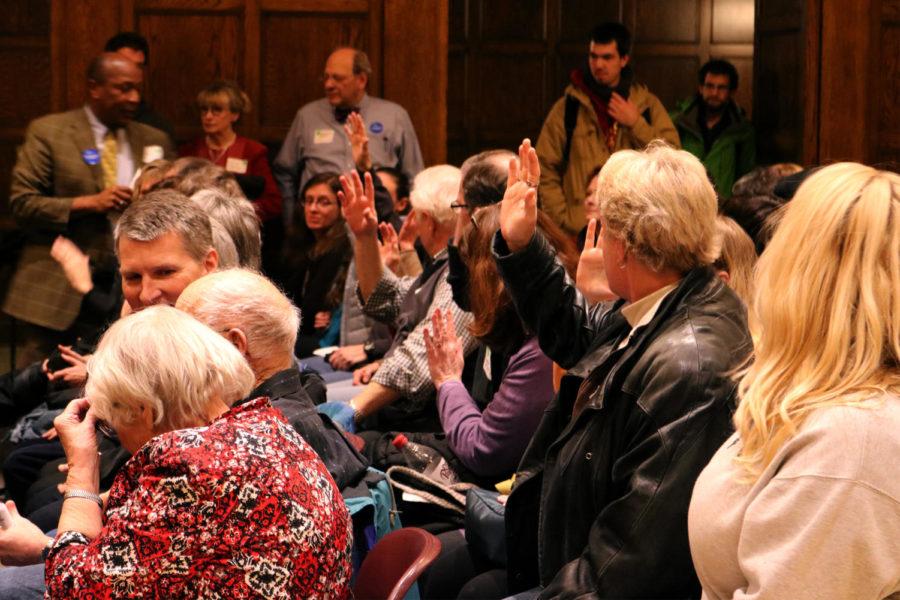- News
- News / Politics And Administration
- News / Politics And Administration / State
- Politics
- Politics / Caucuses
Democratic Iowa caucus confusion explained
Caucus members in the Grand Ballroom at the Memorial Union raise their hands to signify that their vote has been counted.
February 16, 2016
Unreported and miscast votes with a razor-thin race on the line between Vermont Sen. Bernie Sanders and former Secretary of State Hillary Clinton had left many confused.
In a Feb. 7 press release from the Iowa Democratic Party, Press Secretary Josh Levitt said the party worked with the Sanders and Clinton campaigns to review results from 14 precinct caucuses.
Five precincts were found to have reporting errors. The cause?
“Human reporting errors,” Levitt said.
Human error has been a long-time cause for national criticism of the Iowa Caucus. In 2012 on the Republican side, it was initially reported that Mitt Romney had beaten Rick Santorum by eight votes. Two weeks later, it was confirmed that Santorum had actually beat Romney by 34 votes.
“[Republicans] couldn’t count even though they had a much easier system,” said Mack Shelley, professor of political science.
When asked if the Democrats would ever adopt the straw poll system of the Republicans, Levitt said, “It’s tough to say. We are under certain different rules than the Republicans.”
“I really wish they would. To me that’s a very simple solution,” Shelley said.
But Shelley said the Democratic Party probably doesn’t want to do the exact same process as the Republicans.
“We’re always looking for ways to improve and innovate,” Levitt said. “We’re going to be having a commission to talk about these things and look at how we can improve and move forward.”
One way both parties have tried to innovate was by teaming up with Microsoft to create an app that allowed precincts to use as a reporting tool.
Shelley said the precinct he was at did not use the app.
“The folks in charge at the precinct weren’t trained [to use the app],” Shelley said.
Shelley went to the Democratic caucus this year and said they counted people by having them raise their hand and then slapping it down once they had been accounted for.
“There’s no real definitive way to count the votes,” Shelley said. “When you have this vote counting process that isn’t run as an official state election the rules are haphazard at best.”
One process that received extra national criticism this year was the coin toss, which was used for ties in precincts that allocate an odd number of delegates.
“I think it’s important for people to understand solely what the coin toss is,” Levitt said. “These are not determining the entire plate of county delegates; just one delegate.”
Allegations that Clinton won the caucus because she won all seven coin flips that night is untrue, Shelley and Levitt both said.
Levitt said each candidate won coin flops, and Shelley said it could not have made a difference of six whole delegates.
The Sanders campaign had requested the raw vote count to be released, but the Iowa Democratic Party shows no inclination of those votes being released.
Because the process itself seems unlikely to change, Shelley suggests the Democrats report the results differently.
One suggestion Shelley had was instead of reporting the first round votes, the Democrats could report the second-round vote totals and the delegate equivalents.
“I don’t see anything wrong with that at all,” Shelley said.
Shelley said if the party is going to be “stubborn” and refuse to release the number of votes, an alternative would be to release the exact number of delegates since the delegates are what matter.
“It is a four-tier process, and I really don’t think most people really understand that,” Shelley said.
Most people believe the delegate allocation that took place is what sends people to the national convention.
“It’s really just the first step,” Shelley said.
Delegates elected at their precinct caucus go on to the county convention, then district convention, state convention and national convention.
“The way you win in the end is by showing up to the state convention,” Shelley said.







